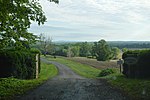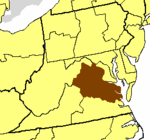First Battle of Rappahannock Station
1862 in Virginia1862 in the American Civil WarAugust 1862 eventsBattles of the American Civil War in VirginiaBattles of the Eastern Theater of the American Civil War ... and 4 more
Culpeper County in the American Civil WarFauquier County in the American Civil WarInconclusive battles of the American Civil WarNorthern Virginia campaign

The First Battle of Rappahannock Station, (also known as Waterloo Bridge, White Sulphur Springs, Lee Springs, and Freeman's Ford) as took place on August 23, 1862, at present-day Remington, Virginia, as part of the Northern Virginia Campaign of the American Civil War.
Excerpt from the Wikipedia article First Battle of Rappahannock Station (License: CC BY-SA 3.0, Authors, Images).First Battle of Rappahannock Station
Hubbards Road,
Geographical coordinates (GPS) Address Nearby Places Show on map
Geographical coordinates (GPS)
| Latitude | Longitude |
|---|---|
| N 38.5272 ° | E -77.8302 ° |
Address
Hubbards Road
Hubbards Road
22734
Virginia, United States
Open on Google Maps









